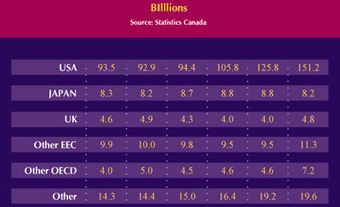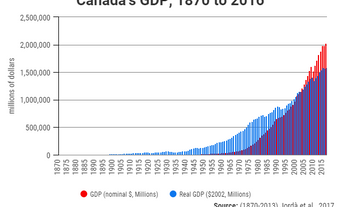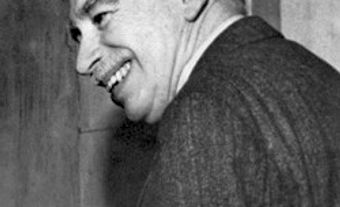Macroeconomics is a field of economics that studies economic behaviour in the aggregate, or as a whole. It investigates economic issues such as employment, national income, price inflation and international trade. By contrast, microeconomics studies the behaviour of individuals and firms in allocating scarce resources.
Macroeconomics emerged in the 1930s as a separate field largely in response to the Great Depression. Macroeconomists often use aggregate measures to study the structure and behaviour of the entire economy. Some of those measures include gross domestic product (GDP), unemployment rate, interest rates, economic growth rates and price indices (see Consumer Price Index). This branch of economics is closely tied to government policy, especially fiscal policy (government spending with the aim of stimulating the economy) and monetary policy (policies related to the supply of money). Developments in macroeconomic theory often affect the monetary policies of central banks, such as the Bank of Canada and the United States’ Federal Reserve, that in turn have an impact on the cost of living and economic stability around the world.
Origins and Keynesianism
Before the early 20th century, most economic analysis focused on the behaviour of individuals, firms, and industries. The classical school of economic thought was dominant and was derived from theories of philosophers such as Adam Smith, David Ricardo and John Stuart Mill. This group of economic thinkers, in general, made the case that government intervention in most areas of the economy would be ineffective. Adam Smith argued that competition between individuals led to markets regulating themselves via an “invisible hand” and that the economy as a whole benefited from each member pursuing their own self-interest. David Ricardo believed that boom and bust cycles were temporary and that the economy always adjusted in the long run. These classical economists also refuted previous Mercantilist views of economics by arguing that free and unfettered trade benefited both parties.
By the 1930s, the Great Depression challenged this view of economics. A worldwide recession persisted for more than a decade, causing a massive stock market crash and leaving millions of people in the US and Canada unemployed. Modern macroeconomics was born in this era with the publication of The General Theory of Employment, Interest and Money by John Maynard Keynes in 1936. The British economist argued that, in the short run, prices could be “sticky” and prevent adjustment back to full employment.
Keynes posited that governments must intervene in these situations with fiscal policy. Keynes and his followers argued that because governments are in the unique position of controlling tax revenues, they can boost demand by spending on goods and services during recessions. Keynes’ ideas influenced Canadian governments in the late 1930s and became a deliberate part of government policy after the Second World War broke out in 1939. The massive public spending required by the war finally reduced unemployment to minimal levels by 1942. (See also Keynesian Economics in Canada.)
Monetarism
In the mid-1970s, the United States and Canada experienced very high levels of inflation. Those trends, combined with new theoretical developments in the field of economics, led to the rising influence of monetarism. Monetarist economists argued for a neutral monetary policy in which money-supply growth rates are set and maintained at low levels, except in extreme economic circumstances (see Monetary Policy).
Did you know?
University of Chicago economist Milton Friedman became an influential economic thinker, starting with the publication of A Monetary History of the United States, 1867–1960 in 1963, co-written with Anna J. Schwartz, and “The Role of Monetary Policy” in 1968. Friedman’s analysis was that monetary policy was a more effective tool than fiscal policy — although the government is still limited in its ability to fine-tune the economy — and that there is a natural rate of unemployment. If unemployment drops below that rate, inflation will accelerate, Friedman argued.Friedman also had an alternative explanation of the Great Depression: he believed it was caused by the failure of the Federal Reserve, the US central bank, to increase the money supply. Friedman and other economists emphasizing free-market policies that minimize government interference are often referred to as the Chicago School.
In the world of government policy, monetarism represented a break from Keynesian economics because it asserted that monetary policy was a better tool than fiscal policy to manage aggregate demand. This essentially meant that governments are better off slowly increasing the money supply to counter recessions rather than increasing government spending. Today, the main objective of the Bank of Canada’s monetary policy is to keep inflation low, stable and predictable.
Monetarism enjoyed policy success when the US Federal Reserve under Paul Volcker restricted the money supply and successfully reduced inflation at the cost of a major recession. Its influence declined in the 1980s and 1990s when the velocity of money, or the speed at which money changes hands, became less predictable. Some critics argued that the direct relationship between money supply and nominal gross domestic product (GDP) no longer held, and therefore that monetarist theory was less relevant.
Later Schools of Thought
DSGE Macroeconomics
Macroeconomics became increasingly mathematically sophisticated. In the late 1970s, the American economist Robert Lucas took the ideas of monetarism further by introducing the concepts of rational expectations and stochastic modelling (see Statistics). Lucas’s models argued that individual agents, such as firms, not only took the past into account but also made forward-looking decisions based on current government policy and expected changes in policy. The new approach based on Lucas’s work was called DSGE macroeconomics (DSGE stands for dynamic stochastic general equilibrium).
In 1982, economists Finn E. Kydland and Edward C. Prescott built on Lucas’s work to develop real-business-cycle (RBC) models that describe the fluctuations of the business cycle. Michel De Vroey, an economist who wrote a history of macroeconomics, describes this “Lucasian or DSGE revolution” as a paradigm shift in economic thought.
New Keynesian
Over time, a New Keynesian school of economists also emerged (see Keynesian Economics in Canada). Some of these economists, such as John B. Taylor and Stanley Fischer, built RBC models in the 1980s but included Keynesian assumptions such as the ideas of “sticky” wages and employer contracts. Their work showed that monetary policy is useful for stabilizing the economy in the short run, but only affects prices in the long run.
Did you know?
The 2008 financial crisis and COVID-19 pandemic brought renewed interest in Keynesian approaches, given that both crises required large emergency stimulus spending by governments in Canada, the US, and around the world. (See also Recession of 2008–09 in Canada.) In particular, monetary policy can become impotent in the case of a liquidity trap, where interest rates remain near or at zero and individuals and businesses hoard cash rather than spend it. In such situations, increased government spending may be one solution.More radical approaches, such as modern monetary theory, also gained prominence as central banks embarked on months-long campaigns of quantitative easing, which increased the money supply by buying up government bonds.

 Share on Facebook
Share on Facebook Share on X
Share on X Share by Email
Share by Email Share on Google Classroom
Share on Google Classroom





